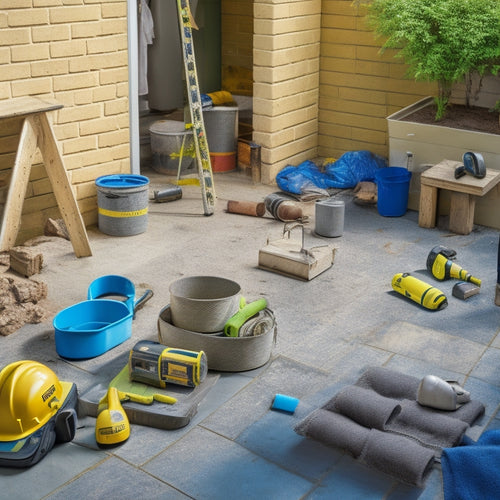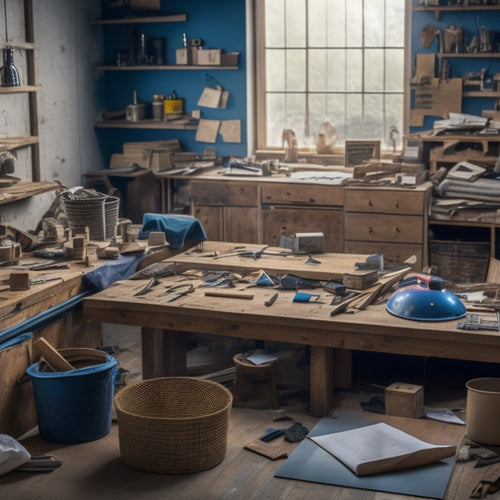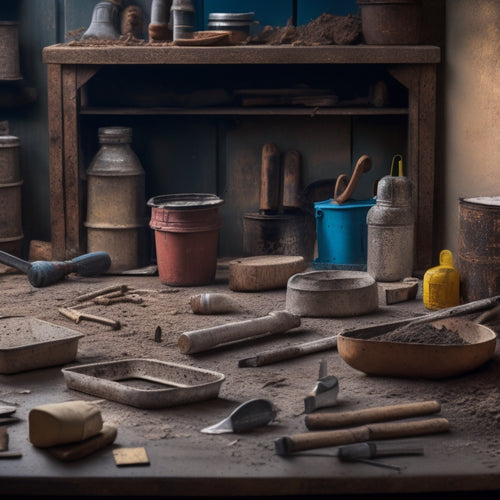
7 Must-Have Safety Gears for Brick Wall Renovation
Share
When renovating a brick wall, you'll face a multitude of hazards, making it essential to wear and use the right safety gear to protect yourself from harm. First, you'll need a hard hat for head protection, safety glasses for eye protection, and a dust mask for respiratory safety. Steel-toed boots will safeguard your feet, while gloves will provide hand protection and grip. A fall protection harness system will reduce fall impact, and debris netting will contain falling objects. By using these seven must-have safety gears, you'll minimize injury risks and guarantee a safe working environment. Now, get ready to learn more about the specifics behind each essential safety gear.
Key Takeaways
- Hard hats are essential for preventing severe head injuries from falling debris and tools during brick wall renovation.
- Safety glasses or goggles protect eyes from dust, flying particles, and debris, ensuring clear vision and preventing injuries.
- Dust masks or respirators filter out airborne contaminants, protecting respiratory health and preventing breathing difficulties.
- Steel-toed boots with slip-resistant soles safeguard feet from heavy objects, falling debris, and slippery surfaces, reducing the risk of injuries.
- Gloves provide hand protection, grip enhancement, and puncture resistance, preventing cuts, abrasions, and other hand injuries during renovation tasks.
Hard Hat for Head Protection
Vigilance is key when tackling a brick wall renovation, and it starts with safeguarding your most valuable asset - your head. You can't afford to take any chances, as even a minor head injury can have severe consequences. That's why wearing a hard hat is non-negotiable.
But not just any hard hat will do; you need one that meets the highest hard hat standards. There are different hard hat types to choose from, each designed to protect you from specific hazards.
Type I hard hats, for instance, are designed to protect against top impacts, while Type II hard hats provide lateral protection as well. You should also consider the material and weight of the hard hat, as well as its comfort level.
Look for hard hats that meet the ANSI Z89.1 standard, which sets the benchmark for impact resistance and penetration protection. Remember, your hard hat is your first line of defense against head injuries, so choose wisely and wear it correctly to guarantee your safety on the job site.
Safety Glasses for Eye Protection
As you hammer away at that brick wall, debris and dust can fly in every direction, putting your eyes at risk of serious injury.
Wearing safety glasses is crucial for eye injury prevention, and it's not just about comfort - it's about protecting your vision.
When choosing safety glasses, consider the following key features:
-
Lens durability: Look for lenses that can withstand impact and scratches.
-
Anti-fog coating: This feature guarantees clear vision even in humid or dusty conditions.
-
Wraparound frame design: This style provides maximum protection from debris entering from the side.
Dust Mask for Respiratory Safety
When you're renovating a brick wall, the air can quickly become thick with dust and debris, posing a significant threat to your respiratory health.
Without proper protection, you're at risk of inhaling harmful particles that can cause serious health problems. That's why a dust mask is an essential safety gear for brick wall renovation.
A dust mask is designed to filter out dust, debris, and other airborne contaminants, allowing you to breathe safely while working.
When choosing a mask, look for one that fits snugly over your nose and mouth, ensuring a proper seal. A good mask fit is vital, as it prevents particles from seeping in through gaps.
Opt for a mask with a high-efficiency filter, such as a HEPA filter, which can capture 99.97% of particles as small as 0.3 microns.
Steel-Toed Boots for Foot Safety
Safety begins from the ground up, and that's why protecting your feet is essential when renovating a brick wall.
You'll be working with heavy materials, power tools, and debris, which can cause serious foot injuries. Steel-toed boots are a must-have to prevent crushed toes, puncture wounds, and other foot-related injuries.
Steel-toed boots offer several benefits, including:
- Protection from heavy objects and falling debris
- Resistance to punctures from sharp objects
- Slip-resistant soles to prevent slips and falls
To guarantee your steel-toed boots continue to provide the best protection, you'll need to perform regular boot maintenance.
This includes cleaning your boots regularly, inspecting them for signs of wear and tear, and storing them in a dry place.
Additionally, consider replacing your boots every six to twelve months or sooner if you notice significant wear.
Gloves for Hand Protection and Grip
Several hundred pounds of weight can come crashing down on your hands during a brick wall renovation, making hand protection essential to preventing serious injuries.
You need gloves that can withstand the force of falling debris and provide grip enhancement to prevent slipping and dropping heavy objects.
When selecting gloves for hand protection, look for materials that offer durability, puncture resistance, and grip enhancement.
Leather, synthetic, and hybrid gloves are popular choices for brick wall renovation. Leather gloves provide excellent grip and abrasion resistance, while synthetic gloves are more affordable and offer better puncture resistance. Hybrid gloves combine the benefits of both materials.
Ensure the gloves fit snugly to prevent blisters and discomfort during extended wear.
Additionally, consider gloves with reinforced palms, fingertips, and thumbs for added protection. Some gloves feature grip patterns on the palm to enhance grip and reduce slippage.
Don't compromise on hand protection – choose gloves that meet industry standards for safety and performance.
Fall Protection Harness System
As you ascend scaffolding or ladders during a brick wall renovation, the risk of falls increases, making it essential to wear a fall protection harness system that can catch you in case you slip or lose your balance.
This system is designed to absorb the shock of a fall, reducing the impact on your body.
To guarantee your safety, make sure to:
- Conduct regular harness adjustments to guarantee a secure fit
- Choose a harness that's certified for fall arrest, with a capacity to support your weight
- Inspect your harness regularly for signs of wear and tear, and replace it if necessary
Debris Netting for Site Safety
When installing debris netting for site safety during your brick wall renovation, you'll need to take into account the installation methods that work best for your project, such as attaching nets to scaffolding or suspending them from rooftops.
The effectiveness of debris containment also depends on the netting's ability to catch and hold falling objects, which is influenced by factors like mesh size and material strength.
Netting Installation Methods
During brick wall renovation, you'll need to prioritize site safety by installing debris netting, which entails attaching a high-strength mesh material to surrounding structures or scaffolding to contain falling objects.
This vital step guarantees that debris doesn't harm people or damage property during demolition or reconstruction.
When it comes to netting installation methods, you have several options to choose from, depending on the specific requirements of your project.
Here are a few techniques to take into account:
-
Suspension method: This involves suspending the netting from a stable structure, such as a roof or scaffolding, using ropes or cables.
-
Frame method: This technique involves attaching the netting to a freestanding frame, which is then secured to the ground or surrounding structures.
-
Wrap method: This method involves wrapping the netting around a structure, such as a column or beam, to create a secure containment system.
Regardless of the installation technique you choose, it's important to verify that the netting is securely attached and can withstand the weight and impact of falling debris.
Debris Containment Effectiveness
You invest time and resources into debris netting installation to confirm site safety, so it's crucial to assess the effectiveness of your containment system. A well-designed debris management strategy relies on a combination of containment strategies to prevent debris from escaping the work zone.
| Containment Strategy | Effectiveness |
|---|---|
| Debris netting | High - Effective in containing large debris, but may not capture smaller particles |
| Dust screens | Medium - Useful for containing dust and smaller particles, but may not be effective for larger debris |
| Enclosed scaffolding | High - Provides a physical barrier to contain debris, but may be more expensive |
| Ground covers | Low - Limited effectiveness in containing debris, but can help with cleanup |
When evaluating the effectiveness of your containment system, consider factors such as the type of debris, wind direction, and proximity to surrounding structures. By understanding the strengths and weaknesses of each containment strategy, you can optimize your debris management plan to confirm a safe working environment.
Mesh Size Options
Debris netting is a key component of an effective containment system, and mesh size is a critical factor in determining its performance. When selecting a debris netting for your brick wall renovation, you'll need to take into account the mesh size options carefully. The right mesh size will guarantee that debris is effectively contained, preventing damage to surrounding areas and reducing the risk of injury.
-
A smaller mesh size (1/4 inch or smaller) is ideal for containing fine dust and debris, making it a great choice for interior renovations.
-
A medium mesh size (1/2 inch to 1 inch) provides a good balance between containment and airflow, making it suitable for most renovation projects.
-
A larger mesh size (1 1/2 inch or larger) allows for more airflow and is often used for exterior renovations where wind and weather are a concern.
When evaluating mesh size options, you should also take into account the mesh types and mesh durability.
Look for debris netting made from durable materials that can withstand the demands of your renovation project. By selecting the right mesh size and type, you can guarantee that your debris netting performs effectively and keeps your site safe.
Frequently Asked Questions
Can I Wear Regular Glasses Instead of Safety Glasses?
You shouldn't wear regular glasses instead of safety glasses, as they don't provide sufficient vision protection. Opt for safety eyewear alternatives that meet ANSI standards, ensuring your eyes are protected from debris and hazardous materials.
Are Steel-Toed Boots Necessary for Small Renovation Projects?
When tackling small renovation projects, you're wise to wear steel-toed boots, as they offer essential advantages in injury prevention, protecting your feet from heavy objects, sharp debris, and other hazards that can cause serious harm.
How Often Should I Replace My Dust Mask Filters?
When breathing easy on the job site is a must, you'll want to swap out those dust mask filters every 1-3 months, depending on usage and dust mask types, to guarantee ideal filter maintenance and a healthy you!
Can I Use a Ladder Without a Fall Protection Harness?
You shouldn't use a ladder without a fall protection harness, as it's a major fall hazard; ladder safety guidelines emphasize the importance of proper anchoring and harnessing to prevent serious injuries or fatalities.
Is Debris Netting Required for Indoor Brick Wall Renovations?
When renovating an indoor brick wall, you'll face hazards like falling debris and dust; consider installing debris netting to contain and reduce these risks, as its benefits include minimizing damage and protecting people and property.
Conclusion
You've got the essentials for a safe brick wall renovation. Remember, safety isn't just a priority, it's a necessity. Did you know that according to OSHA, falls are the leading cause of fatalities in the construction industry, accounting for over 39% of all fatalities? By wearing a fall protection harness system and following proper protocols, you can greatly reduce the risk of accidents and guarantee a successful project. Stay protected, stay safe!
Related Posts
-

7 Patio Safety Tips for DIY Renovation Projects
As you begin your DIY patio renovation project, prioritize safety by evaluating the worksite for tripping hazards and...
-

7 Best Home Renovation Project Checklists With Timelines
You're about to initiate a home renovation project, and establishing a clear plan with timelines is vital to staying ...
-

Trowel Tool Cost for DIY Home Renovation Projects
When it comes to your DIY home renovation project, you'll need to budget for a variety of trowel tools, including stu...


